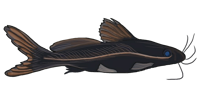The.Dark.One wrote:No, I think what Mats means is "mainstream" science i.e. Ferraris considers it a full genus, whereas specialist (in terms of loricariids) science i.e Armbruster (followed by Lujan et al) use it as a subgenus.
Suckermouth wrote:
FWIW, Ferraris was already outdated when it was published; it did not take into consideration most of Armbruster's changes; this is the example I can think of off the top of my head, but certainly numerous other changes between 2004 and 2007 also slipped past the Ferraris review.
I agree with Milton, which is why I was confused about the "mainstream science" statement. The reason why the subgenera may have not been picked up by Ferraris (2007), and not even mentioned in his remarks, was possibly because Armbruster (2004) incorrectly spelt
Panaqolus as
Panaquolus. I don't really know why it wasn't mentioned; maybe Ferraris wanted to avoid using subgenera, but surely he would have commented, had he known (as he did for others)? Basically, Ferraris (2007) for whatever reason ignored the changes.
Suffice to say, I do not see a distinction between these "types" of science. Armbruster and the folks at Auburn are the leading lab working on
Panaque, if not all loricariids, so I don't see where there is any other qualified difference of opinion. There has been no scientific discussion stating any other hypotheses. Ferraris (2007) was a checklist, not a critical review. If he had mentioned the changes and justified disregarding the subgenera, things would have been different, and there would be a case.
As far as I am concerned, Armbruster (2004) and the use of his subgenera is entirely valid (I may not like the use of subgenera, but it is scientifically valid) and has not been contradicted. This is the "mainstream science".
Jools wrote:Hypostomus(Cochliodon). I know they're not subgenera but the issue I struggle with is what's a subgenus and what's a species group ... I don't understand why subgenera is used in the Panaque example and why species grouping is used in Hypostomus.
Jon Armbruster website wrote:The genus [Hypostomus] was monophyletic in all analyses, but the phylogenies have provided no good methods of splitting the genus up further. Certainly Cochliodon and Watawata are synonyms of Hypostomus, and Aphanotorulus, Squaliforma, and Isorineloricaria form a monophyletic group. At most, it might be necessary to recognize a separate genus for Aphanotorulus, Isorineloricaria and Squaliforma together, but there is currently no good evidence to support this and certainly no evidence at all to recognize any other taxa.
The website partly explains the situation, but from what I can gather from Armbruster & Souza (2005), insufficient taxa were available to fully elucidate the relationships among
Hypostomus. Calling something a species group is an informal way of expressing relationships, especially when evidence is flimsy and you aren't sure of the monophyly. Having to constantly revise messy nomenclature is something best avoided in these cases.
Regarding the names. If the call was mine, here's what I would do:
My first choice, as unpalatable as it might sound, would be to: follow Armbruster and subsume both
Panaqolus and
Scobiancistrus into
Panaque, ignore the subgenera in the name, while making a comment on the cat-elog page notes stating the subgeneric classification.
My second choice would be to change the genus to subgenus (i.e.
Scobiancistrus auratus, Panaqolus dentex, Panaque nigrolineatus), ignore the subgenera, but again, make a comment to that effect in notes.
Shane wrote:Is there really any reason to incorporate subgenera into the Cat-eLog? Will such a distinction really help the average Cat-elog user? Besides, it is already addressed in every entry... which could be easily tweaked to reflect the subgenus designation.
I entirely agree with Shane here. I would completely avoid using subgenera, tweaked or otherwise. Far too confusing for all concerned.








 changae[ /clog] - even if the latter is technically more scientifically correct./g/s/1.jpg)


/g/s/1.jpg)